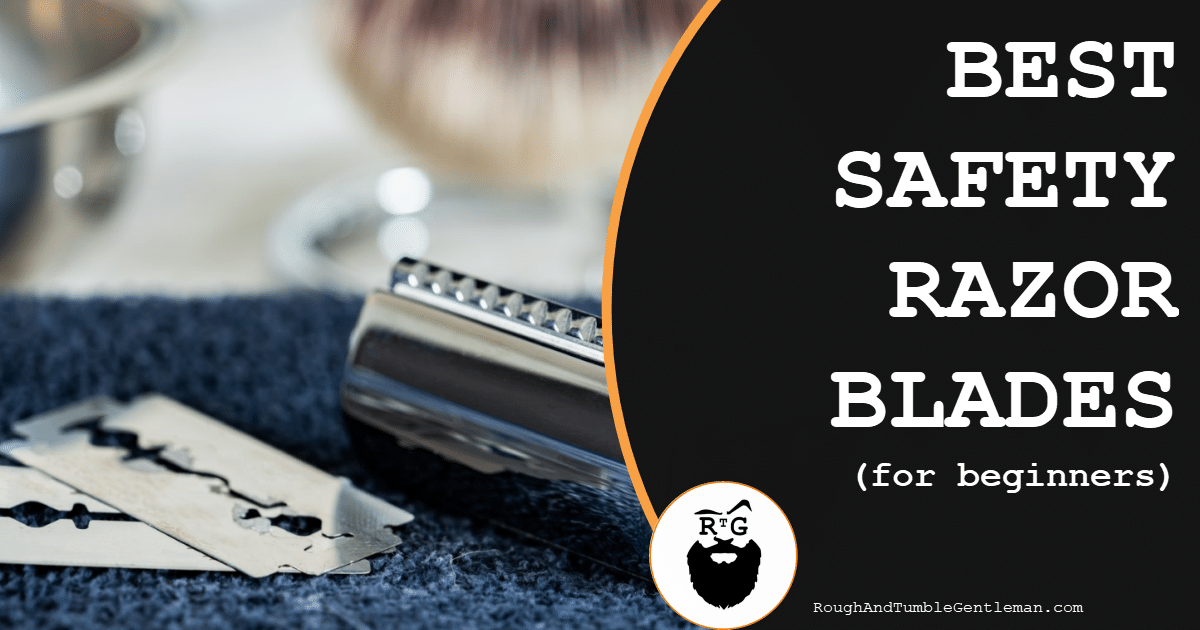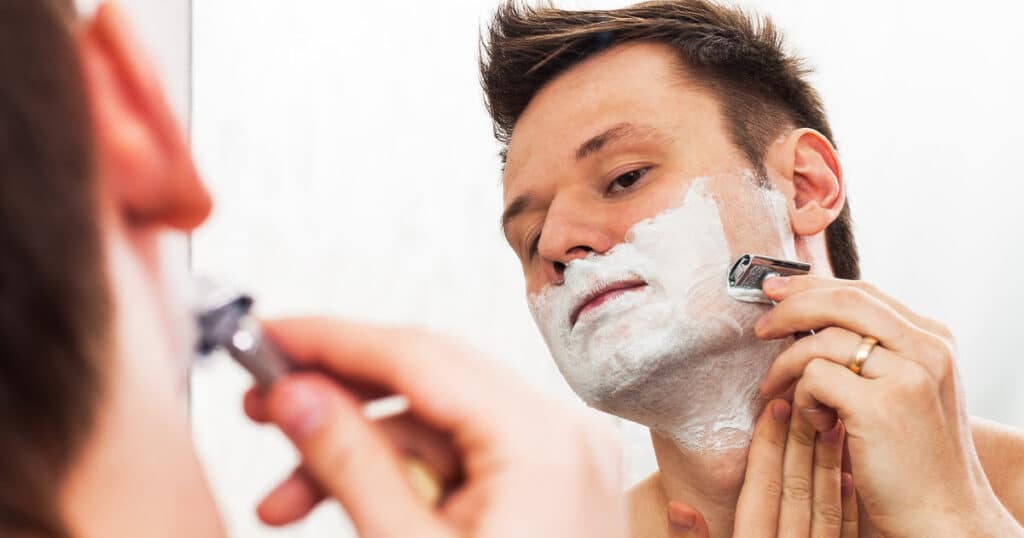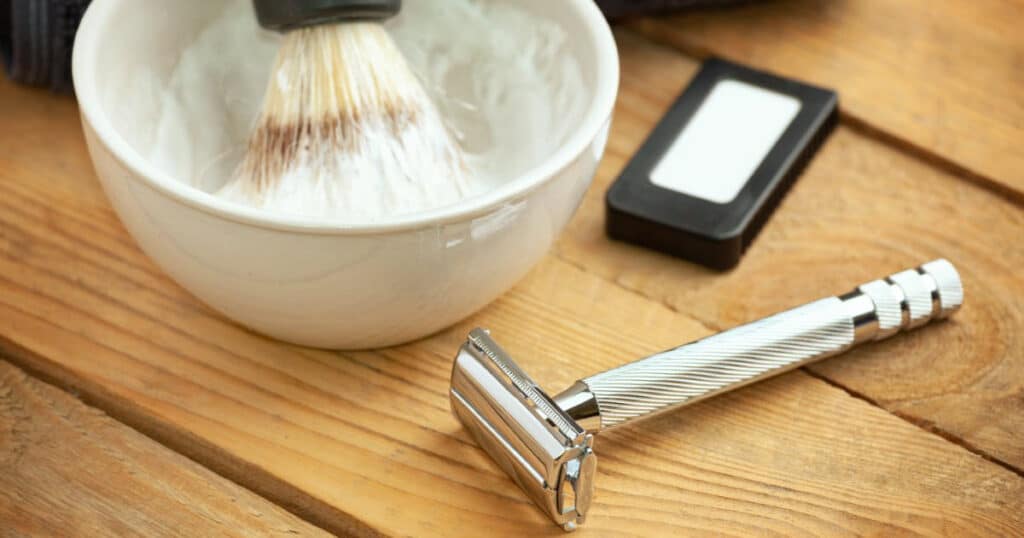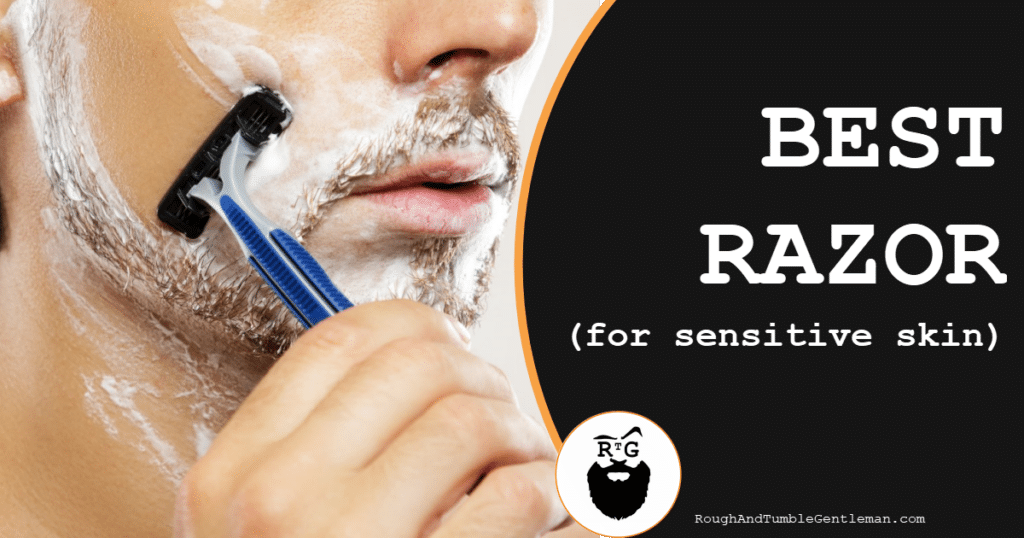You can’t shave without a blade, and when you’re new to wet shaving, it seems like all the different blade options available to you can make your head spin. So to make things easier, we’ve gathered our picks for the best safety razor blades for beginners, and laid them all out below.
These are the blades we think will be easy to use when you’re just getting started with safeties. The blades we’ve chosen are mostly smooth and forgiving, so as to prevent unpleasant cuts as you learn how to handle a double-edge razor.
If we were only to recommend one, then in our view the best safety razor blades for beginners are the Astra Superior Platinum Blades, which we feel have the perfect middle ground of sharpness and smoothness for first-timers and those still learning to use a safety razor.

Alrighty! Let’s get into it and explore all of the safety razor blades that made the cut. (sorry, we had to)
Newbie Blades: Quick Picks
We’ll get into the details below—and we have a surprising amount say when it comes to blades!—but here’s a quick summary of our reviews, if you’re in a rush:
#1: Best Overall Pick: Astra Superior Platinum Blades. These classic blades are crowd-pleasers. They’re designed to glide smoothly and they’re sharp enough to cut the hair without much of a risk of nicking the skin, making them an excellent starting point.
#2: Another Great Balanced Option: Personna Double Edge Razor Blades. A hint sharper than Astra but still quite smooth, these blades give a closer shave with minimal risk of irritation, for beginners with slightly coarser hair growth.
#3: Extra-Mild and Smooth: Derby Premium Razor Blades. If you’d like to keep things extra mild, Derby Premium blades are quadruple-coated. They’re not very sharp but they are smooth, so they’re a nice choice for beginners with sensitive skin or fine hair.
#4: Extra-Sharp: Feather Hi-Stainless Safety Razor Blades. These super-sharp blades are not for the faint of heart, but if you have a very coarse beard and you’re set on trying something a little more aggressive, these are the gold standard.
#5: Try Them All: The Razor Blade Sampler Pack 100 Count. No matter how many reviews you read, nothing compares to trying different blades until you find your perfect match. Sampler packs are an easy way to try all of the most popular blades to see what works for you.
Gents, we are reader supported. If you click on a link we may shave a small commission at no additional cost to you.
The Best Safety Razor Blades for Beginners: Our Recommendations
Let’s get detailed!
Best Overall Pick: Astra Superior Platinum Blades

Astra Superior Platinum Blades are our favorite option for beginners. Nowadays, they’re made by a Gillette subsidiary in Russia, so they’re designed for a certain level of consistency and quality. These blades are famously smooth with an easy glide that isn’t very likely to irritate the skin.
We think they have the right level of sharpness for most beginners. By that, we mean that they’re not so sharp as to nick the skin easily, but they’re still sharp enough to cut even through thicker hair. If your hair is medium-coarse, you may choose to keep using them even as you gain experience.
Uniquely, we find that Astra blades get a little sharper after the first shave, likely as a result of their platinum coating wearing off to reveal a finer edge of stainless steel. This is the inverse of what we’re used to, but it’s a point in favor of these blades’ durability.
Another Great Balanced Option: Personna Double Edge Razor Blades

In the second spot we have the Personna Double Edge Razor Blades. Made in Germany, we find that they’re a touch more high-end than Astra Platinums. Both blade brands are wildly popular in wet shaving circles, and deciding which deserved the top spot was difficult.
We find the Personnas to be a tad sharper than Astra, but still mild enough to suit most beginners. Despite the added sharpness, we still find that the Personas are very smooth, which is our top requirement out of a razor blade for beginners. Because they’re smooth, they don’t tug too much on skin and hairs, which keeps the risk of irritation low. Your mileage may vary, though, of course.
It’s worth mentioning that there’s some confusion regarding Personna brand blades. These German-made ones are considered the equivalent of the now discontinued Israeli-made “Personna Reds.” They are somewhat sharper than the also popular “Personna Lab Blues.”
Extra-Mild and Smooth: Derby Premium Double Edge Razor Blades

Adding Derby Premium Double Edge Razor Blades to our list might be a controversial decision. This brand doesn’t have the best reputation, in large part because their blades are not particularly sharp straight out of the pack. This can be quite frustrating for experienced wet shavers, but if you’re a newcomer, this might actually appeal to you.
Derby blades are made of stainless steel, but they have a robust coating of chromium, ceramic, platinum, and tungsten… and while that sounds like a bad thing, it’s actually a strong feature.
Because of the coating, what the Derby Premiums lack in sharpness they can make up for in smoothness. We find that they provide excellent glide, even if we need a couple of passes to get a close shave.
If you have very sensitive skin and your hair isn’t very coarse, these may be good blades for you to start with.
Extra-Sharp: Feather Hi-Stainless Safety Razor Blades

You will often find bloggers pitting Feathers and Astras against each other. Both blade brands are extremely popular, with quality blades made of platinum. The main difference is in sharpness, with Feathers offering a much more potent slice, and that’s why we’ve included Feather Hi-Stainless Safety Razor Blades.
Feather razor blades are considered to be some of the sharpest blades on the market, which can be a blessing or a curse for beginners. If you have very coarse hair or you’re starting out with a very mild razor, these aggressive blades might be worthwhile. If your skin is sensitive or a little bumpy you may want to stay away, because these suckers can cut.
Another detail we love about Feather blades is how consistent they tend to be. These razors are made in Japan, a country that deserves its reputation for high-quality production. The chances of finding a dud in a pack of Feathers are quite low (but pobody’s nerfect, so make sure to examine every fresh blade before popping it into your DE razor!).
Try Them All: Razor Blade Sampler Pack 100 Count

Last, but not even a little bit the least, is the option we probably recommend the most: a sampler pack. Here we’ve got the Blade Sampler Pack 100-Count.
We’re often surprised when a blade we love doesn’t work for a person with the same beard type as us, even when they’re using the same razor! No matter how hard we try to be analytical, these things are sometimes unpredictable.
So no matter how many reviews you read and how much you analyze your own hair type, sometimes the only way to find the best blade for you is to try a lot of different ones. This sampler pack lets you do just that. It includes all of the blades we’ve recommended in this guide so far, as well as a few others that almost made it to the list.
As you go through a pack like this, we suggest you start with medium-sharp blades like Astra or Personna. If they’re too aggressive, switch to something milder like Derby. If you think they could be sharper, move on to Feather next.
Alrighty! There you have it: our suggestions when it comes to the best safety razor blades for beginners. Hopefully there’s something here that helps you, and as you start your journey with safety razors, just remember: 1) you need to be careful, because safety razor blades really are very sharp; 2) you probably will get cut a few times, regardless of what kind of razors you use; and 3) you’ll gain skill as you practice, and you’ll probably get a lot fewer nicks and cuts as you go along.
With all that said, now that we’re here, let’s start asking the real questions:
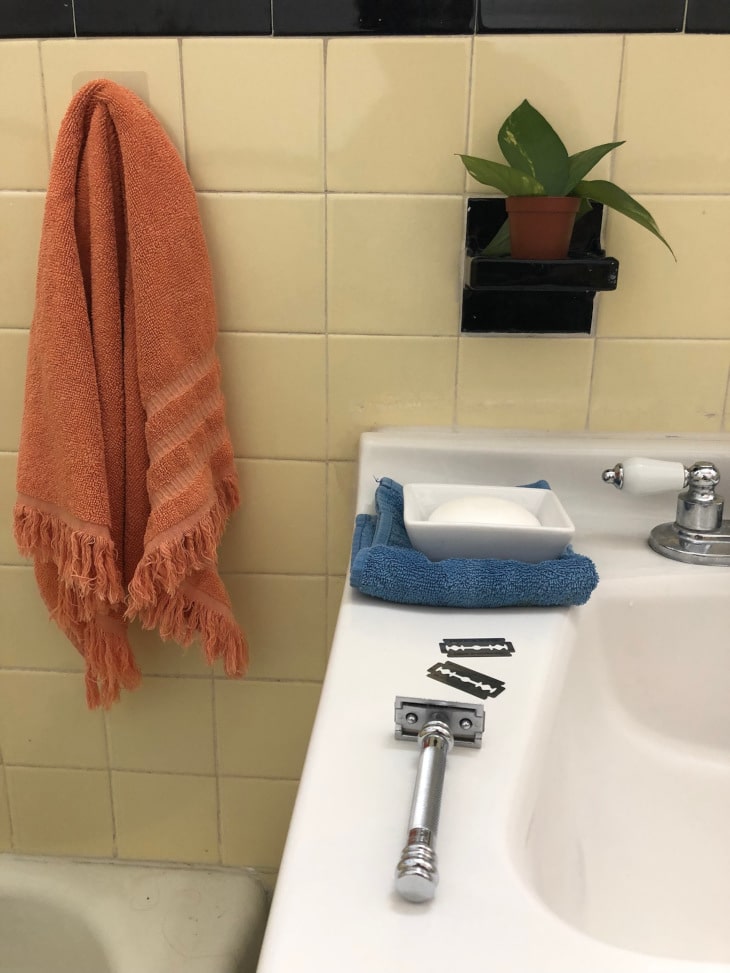
What Makes a Good Safety Razor Blade?
No matter how much experience you have as a wet shaver, there are some elements you don’t want to compromise on when choosing a razor blade.
Quality #1: Smoothness
Smoothness is an interesting factor in razor blades. It’s incredibly important, but it’s also difficult to quantify. Unlike sharpness, which refers to how easily a blade cuts through hair, smoothness is a question of how the blade passes over the skin.
The two are related—a very dull blade will catch on every hair, so it won’t feel very smooth, but a very sharp blade can scratch areas where the skin is a little uneven, which also takes away from its smoothness. The smoothest blades are usually balanced, so they’re not too sharp or too dull.
This factor impacts just how pleasant your shave is. If you have sensitive skin, shaving with a smooth blade is less likely to irritate your skin.
Interestingly, some users find that as they gain experience, they like a blade that’s not overly smooth because it can “give them feedback,” meaning that it slightly pulls where the hair hasn’t been shaved close enough. This preference is quite rare, though. For beginners, we don’t think this needs to be much of a concern, but as you gain practice you might find yourself preferring a blade that’s less smooth.
Quality #2: Consistency
Good razor blades are made in factories that perform rigorous quality assurance on each and every blade. That’s why we selected razors from brands that have a good reputation as far as consistency is concerned.
Consistency can be a question of overall blade quality and safety, since an uneven blade is more likely to cut or irritate the skin.
However, it’s also a question of knowing what to expect—a big part of wet shaving is developing muscle memory, and for that, we rely on each razor blade to perform the same as its predecessor in the pack.
Quality #3: Performance Over Time
Originally, we were going to call this section “durability,” but on further reflection, that isn’t quite right. Good DE blades don’t have to be particularly rugged or durable since they’re inherently pretty cheap and they generally are meant to be replaced often.
That said, there is something to be said for a razor that maintains consistent performance over the course of 3-4 shaves vs one that becomes atrocious to use on the third shave. Naturally, we prefer the latter.
It’s also interesting to note how a razor can become a little milder or sharper with time—sometimes, reduced or changed performance over time can be a positive rather than a negative.
Some days, when you have longer growth, you want the sharper early shave, but a day later when it’s just time for a touch-up, a smoother and milder shave might feel better on your skin. Consider this a very tertiary feature, but one worth being aware of nevertheless.

How to Choose Your First Safety Razor Blade
Some factors that make a good razor blade are universal, but others are more individualized. Here are our suggestions for how to figure out what you’ll need out of your first razor blade.
Keep It Mild-Ish to Start
Blades are usually judged on a scale from mild to sharp (which we sometimes also call “aggressive,” although that term is more closely associated with razor head design). While it can be tempting to go for the sharpest blade you can find, we actually recommend against it.
Your first razor blade pack shouldn’t be dull, but it also shouldn’t be so sharp as to slice through anything too easily. It’s not a chef’s knife, after all! Your razor blade should be sharp enough to cut through your hair (and we talk about that a bit more in the next section), but as you start out it shouldn’t be sharp enough to cut easily through your skin.
The skin under our beards (or whatever else we’re shaving) is always slightly textured, so if you use a very sharp blade, you’re more likely to end up with small cuts. The right blade will glide over that texture, slice through the hair but not the skin below it.
As you become more experienced, you’ll have more control over your shaving technique and you’ll be able to use a very sharp blade without cutting yourself. You may even be able to move onto more aggressive safety razors, like open comb razors and slant razors. At the start, however, it’s best to keep it mild.
Consider Your Hair and Skin Type
While we do suggest you keep things mild to start, you should also briefly consider the state of your whiskers and the skin below them since that can also impact the right level of sharpness for you.

Fine Hair. Fine hair is pliant, so you don’t need a sharp blade to cut it easily and still achieve a close shave. If you’re a beginner with fine hair, it’s a no-brainer that a smooth, mild blade like the Derby Premium is the best choice to start.
Medium Hair. If your beard hair is about medium-coarse, the best blade will probably be somewhere in the middle, like the Astra Superior or Personna—not too sharp or too mild. As you gain practice, you may find you enjoy a closer shave with a sharper blade, but they’re best avoided to start.
Coarse Hair. You might be tempted to try the sharpest blade available if your beard hair is quite tough and coarse. However, if it’s your first time using a double-edge razor, we still suggest keeping it balanced with an option like the Personna. Eventually, you can progress to a very sharp blade like Feather which will give you the easiest shave.
Sensitive Skin. If your skin is a little more sensitive, meaning that it’s acne-prone or becomes easily irritated, then a mild, smooth blade is your best. If your beard isn’t too coarse, opt for the mild and gentle Derby Premium, but if you need the added sharpness, you might prefer the Astra Platinum.
Consider Your Razor
Razor and blade, blade and razor. One cannot work without the other, and you cannot judge the performance of one without taking into account the performance of the other.
Razor blade sizes are quite standardized, so every blade will fit in every modern double-edge safety razor.
Wet shavers with multiple razors often find that they prefer different blades in different razors. The best way to figure out what works for you is through informed trial and error (which usually means buying a sampler pack to start).
This starts with taking into account how aggressive your razor is.
Mild Razors. In our guide to the Best Safety Razor for Beginners, we mostly suggest milder but hefty razors that offer less room for error. With most of those razors, like the Merkur 34c and Edwin Jagger, medium blades like Astra Platinum are quite unlikely to cut.
These razors are also hefty enough to still support a nice (but not overly close) shave even with a smooth, mild blade like Derby Premium.
Aggressive Razors. While it’s not what we’d recommend, perhaps you’ve been given a more aggressive double-edge razor. This means that it has a bigger gap between the blade and the bottom bar of the razor head. In that case, even if your beard is quite coarse, it might be best to start with a mild blade like the Derby Premium.
Light-weight Razors. Most safety razors are quite hefty. Because of gravity, they naturally bear down on your skin and give you a closer shave. However, some beginners may find themselves with affordable, lightweight double-edge razors. This usually makes for an extra-mild blade, in which case it’s better to err on the sharper side of what you would choose otherwise.
YMMV (Your Mileage May Vary)
YMMV—which stands for “your mileage may vary”—is a phrase that applies to almost any topic related to wet shaving, but it’s particularly relevant for razor blades. Razor blades are very polarizing, so for every die-hard fan of a specific blade, there will also be a hater. This issue is so common that it has become a bit of a cliche!
As many enthusiasts will tell you, the best way to find the best blade for you is just to try a lot of blades. This same principle would be prohibitively expensive when it comes to razors, and it can get costly with other products like soaps or brushes, as well. Thankfully, with razor blades, small packs are usually quite cheap sampler packs are common, so there’s no reason not to try a few blades until you find the one that gives you the perfect shave!
How to Handle a Safety Razor Blade
Once you pick up your new pack of razor blades, here are our must-know tips for handling them safely.
Careful when unwrapping. It can be exciting to open that first new pack of blades but don’t let that distract you from how sharp they can be. The blades are always wrapped individually in wax paper, so remove them from the box carefully.
Make sure your safety razor is already open, ready for you to pop the blade straight inside. Gently unwrap the blade and pull it out by holding it either from top and bottom or along the non-sharp sides. Once you’re ready, slide it into its place in your razor. Different types of safety razors open differently, so make sure you already know how to assemble and disassemble yours. That may seem silly, because most safety razors come in basic two- and three-piece models, but there are some “exotic” models out there, like butterfly safety razors and adjustable safety razors. That’s all for later, though—for now, it makes sense to stick with the two-piece and three-piece models.
Check for defects. Before putting your blade in the razor, take a second to look it over. The edges should be straight and smooth, without any unevenness. Quality control issues are rare when you shop from reputable brands, but this extra step is quick and it can save your skin from potential cuts or irritation.
Shave carefully. Shaving is a whole other story, so if it’s your first time, check out our Ultimate Guide to Wet Shaving before you get started.
Leave blade in razor. Once you’re done shaving, we’re of the opinion that it’s best to leave your blade in the razor. Give the razor a good rinse. If you want, you can disassemble the razor to rinse the blade separately if you think a lot of hair might still be stuck to it.
Let it dry. After you’re done rinsing, leave the blade in the razor, and leave it somewhere safe to dry. Avoid leaving the razor in a humid environment, since even stainless, corrosion-resistance materials can still rust if things are very damp.
How Often Should I Replace My Blades?
You should probably replace your razor blades after every 3-7 shaves.
It’s crucial that you learn to feel when it’s time to replace a blade. When you notice that you need more passes to get a smooth shave or that the blade tugs or drags on your beard more than it did before, it’s probably a sign that it’s time to replace it.
Your personal preferences, hair type, and the sheer amount of real estate you need to shave will all impact the exact number, and you might also discover that some blades last you longer than others.
You May Not Be a Beginner for Long!
Shaving with safety razors may seem a bit intimidating, but everyone has to start somewhere! When putting together this list, we wanted to choose blades that would make it easier for you to learn to shave. It doesn’t take too long to gain practice and build some muscle memory.
Before you know it, you’ll have the experience needed to decide for yourself whether you’d like to move on to newer, slightly sharper blades or if you’ve managed to find your one true love on the first try. Be safe, have fun, and happy shaving!
Michael Morris is the head writer here at Rough and Tumble Gentleman. He's got a ducktail beard and loves Brazilian jiu-jitsu. He's married to the woman of his dreams and lives in Brooklyn, NY.

